Sunday 30 December 2012
Brian Tracy: Achieving Goals is Predictable
Great interview with Brian Tracy on Achieving Goals.
Labels:
Brian Tracy,
secrets of success,
success,
success tips
Wednesday 19 December 2012
The 7 Biggest Mistakes in Social Media Marketing (and How to Avoid Them)
Social media has been around for a while now, and we know that 88 percent of all businesses are now on social media sites in some capacity. That being said, if we look at businesses actually getting value from social media, the number would be much smaller.
I've had the pleasure of working with thousands of businesses on their social media marketing strategies for over six years, and interestingly, the mistakes and barriers to success are the same today as they were when I got started.
Here are the biggest mistakes (and how to avoid them of course).
1-Not having a plan.
Many businesses today still don't have an actual plan or strategic objectives for their social media marketing. They simply "get on Facebook" and assume that posting stuff and having people like them will lead to business value. This isn't necessarily true. To be successful at achieving business goals you need a clear plan for what you want to achieve.
2-Not optimizing content.
One of the most popular questions I get asked is how to connect Twitter, Facebook, LinkedIn, and Google+ accounts so that the same post will spread simultaneously to all accounts. There are tools that let you do this, but why bother? You'll end up with content that isn't right for the medium, and people will start to ignore you. Take a few extra minutes to customize your post for each medium.
3-Posting whatever comes to mind.
Most people decide what to write and then bang away at the keyboard to create a Twitter or Facebook post. Stop, take five minutes, and think about how you can improve it. Can it be more interesting? Can you make it funny? Can you add a relevant stat? Stop vomiting boring crap on your social networks and spend some actual time thinking about what you are going to post!
4-Telling instead of showing.
Stop telling people what you want them to believe about your business and start showing them. I don't have to tell people that I am knowledgeable about social media because I show people with reports, videos, and blog posts. Think about your key value proposition and point of difference vs. your competition, and figure out how to show people via social media.
5-Forgetting relationships.
Relationships still count, and since the dawn of social media people have been preaching the value of conversations and engagement. Remember, you are talking to actual people. They want to be treated with care and respect. Don't just post stuff, but participate and build relationships.
6-Being boring.
Many of the social media accounts that I look at are just plain boring. I'm not sure that there is a formula for interestingness, but (this links back to No. 3) think about how to make your message interesting to your audience: compare it to something else; use a picture or video; find a more relevant way to share your angle. Just stop being boring.
7-Losing focus.
If you try to talk to everyone you'll end up talking to no one. Be focused in your content and your audience. We know that niche content does better online. Be focused and disciplined and you'll be rewarded with loyal followers. Try to please everyone and most people will ignore you.
What mistakes are you seeing in social media? What challenges do you face?
source: http://www.clickz.com/clickz/column/2224663/the-7-biggest-mistakes-in-social-media-marketing-and-how-to-avoid-them
author:Krista Neher
images:http://socialmediainbusiness.com/tag/social-media-applications
Thursday 13 December 2012
Facebook Advertising Guide: All Ad Types and Specs
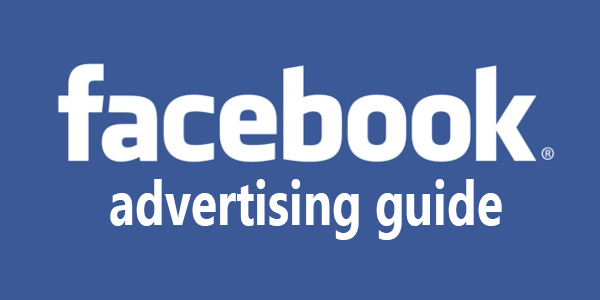
You may love or hate Facebook, but surely it has gained its place in the marketing mix of small business owners. However, despite Facebook’s continuous efforts to drive more businesses to the platform, the information available to potential advertisers is somewhat confusing. This is why this post is a starter’s guide to Facebook advertising, explaining the difference among all the different ad formats.
Facebook Advertising
1. Domain Ads

These ads are the standard solution for advertisers. They run on the right-hand side of the screen on any Facebook page. This type of had can feature up to 25 characters for the headline and 90 for the content. Images are limited to just 99 x 72 pixels, therefore pay attention to readability, if you intend to place some call to action in the image.
2. Page Like Ads

Page Like Ads are not very different from domain ads. However, their purpose is to direct Facebook users to Facebook Pages, Apps, or Events instead of external domains. The specs (characters, picture size) don’t differ from domain ads, except for the headline, that that cannot be edited as it correspond to the name of the Facebook Page, App or Event you are advertising. This is limited to 35 characters.
3. Page Post Ads
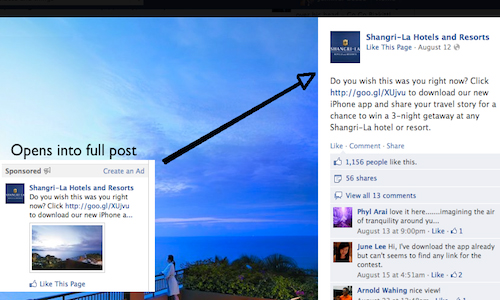
Page Post Ads are probably the best way to engage users and direct them to Facebook Pages. This format allows advertisers to use any “object” they have already posted on their Facebook page and turn it into an ad. In fact a page post ad can be any of the following:
- Page post text ad
- Page post photo ad
- Page post video ad
- Page post link ad
- Page post question ad
- Page post offer ad
- Page post event ad
Page Post Ads are limited to 120 character limit. In case your post text was longer than 120 characters, Facebook will only show the first 120 characters and add three small dots.
Page post ads can also be created directly through the “Promoted” button when posting something.
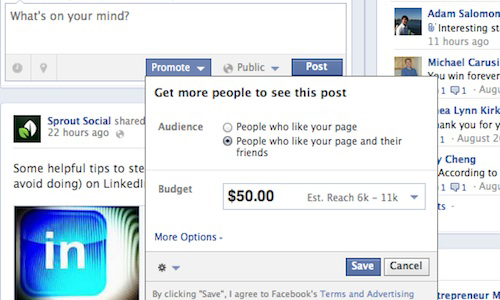
The way the ad is displayed also depends from the target audience, as non-fans will see a “Like” button and will be able to like the page directly from the ad. Current fans instead will see a sponsored story. What is a sponsored story? Read below.
4. Sponsored Stories
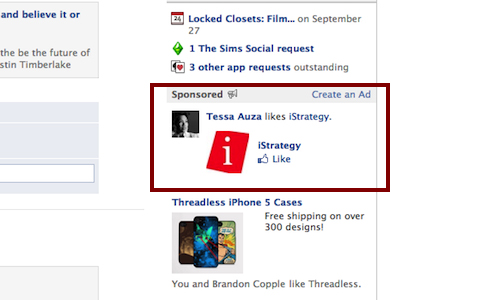
Sponsored stories are probably the trickiest format to understand. So-called (by Facebook) also “voice of friend”, they show users their friend’s interaction with the advertising brand. They always include the friend’s profile picture and their name, along with the action they performed.
This is an extract of how they work (from Facebook Education Resources):
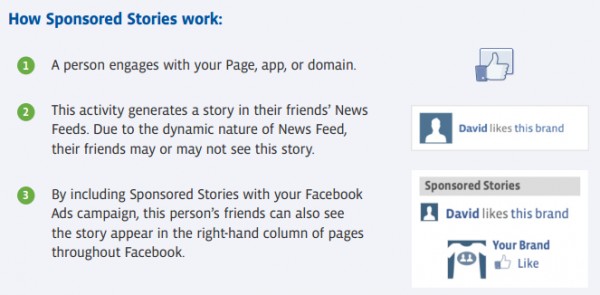
Sponsored stories are displayed only to the friends who took one of these actions:
Liked a Page or a Page post in the last 7 days
Checked into a place or claimed a deal in the last 7 days
Used an app/played a game twice or for >10 min in the last 30 days
Shared an app in the last 14 days
Liked, shared, or posted content from your domain in the last 7 days
You can target mobile-only, desktop-only, or just news feeds.
6. Facebook Offers
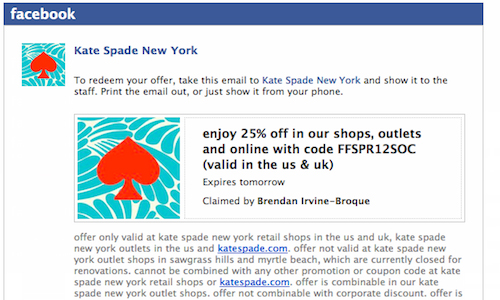
Facebook Offers are a relatively new format that allows local businesses (and more) to advertise coupon codes directly to potential customers. In order to access the discount code, fans have to “claim” the offer by clicking the relevant button. Despite being free to create, their reach is limited, unless advertisers pay for it (surprising, huh?), by turning it into a page post offer ad, like any other page post. Unless promoted, offers only appear in a small share of fans’ news feeds. And their friends will only see it if the offer is claimed.
All the above ad formats can be split between two main categories: Facebook ads and sponsored stories. The bid mechanism is similar to Google Adwords, as the CPC or CPM (cost per thousand impressions) advertisers are charged is determined by a Vickrey auction.
See also : 5 New Ways to Improve Your Facebook EdgeRank
Hope this starter’s guide will be of use to you. If you have any questions, hit me up with questions by commenting below. Good luck!
http://onlineincometeacher.com/socialmedia/facebook-advertising-guide/
Author: Daniel Nathan
Monday 10 December 2012
Maximizing Your Small Business Potential Through Email Marketing
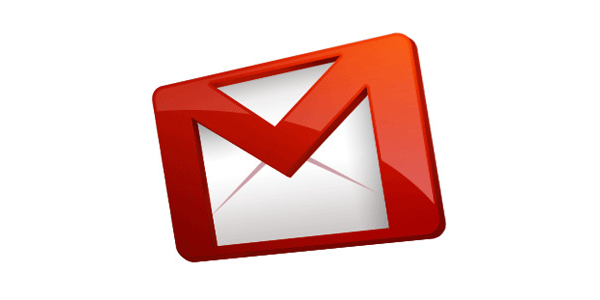
A lot of businesses have been using email marketing for a while, and it has become so common that you might not even think about it as “marketing.” Nevertheless, every time you open an email newsletter, promotional offer or even a “thank you” for buying a product, you are on the receiving end of an email marketing campaign. So let’s get right down to the basics of what email marketing is and whether or not it’s right for you and your small business.
What is Email Marketing?
Email marketing, in the most general sense, is exactly what it sounds like. It refers to marketing campaigns driven by email. But what does that mean? Think about this: every time you’ve ever received a promotional pamphlet on the street, or been handed a coupon for spending X amount of dollars at a retailer, or even simply read a magazine, you’ve been participating in “paper marketing.” Now imagine that instead of being handed a pamphlet, a coupon or a magazine, you receive in your email inbox a promotional message, a printable 10% off coupon, and a company newsletter from a small business. That would be an example of how email marketing works.
Why Email Marketing?
People use email marketing because it works, and it works extremely well, if done correctly. Email marketing allows for a secondary outlet of direct sales, data-driven results, and fosters the relationship between you and your customer. You may have to spend a little bit on email marketing software applications or services, but the amount of money that you save by not using paper and stamps, as well as the proven efficacy of the approach, makes it more of an appealing venture for most businesses. In fact, many small businesses use email marketing in conjunction with social media campaigns as well as; Quick Response (QR) code campaigns and experience great success with this multilateral approach. To top it all off, all of these campaign ideas are environmentally friendly.
Are There Any Downsides to Email Marketing?
There are a couple of downsides if you do not engage in email marketing correctly. A lot of users might label marketed emails as spam, which is something that you do not want. In fact, there are certain situations in which you might be unconsciously breaking the law by not adhering to specific anti-spam guidelines while email marketing!
For example, you cannot send emails to people that have not already agreed to receive them by other means. Fortunately, there are ways to drive reputable email marketing campaigns that adhere to all of the guidelines and do not get you or your small business blacklisted as spam. Unfortunately, without that know-how, you are looking at either studying up or hiring a third party. And to top it all off, you have to make sure that the emails that you are sending are relevant, effective, and aesthetically pleasing. This means design, layout, editing, etc. Without these skills you may be hiring out-of-the-office help, and that can get to be a bit expensive.
Is It For You?
I would definitely suggest looking into it. The numbers don’t lie (you can see them here), and plenty of small businesses profit from the switch rather than suffer from it, as long as they do it correctly. As mentioned before, email marketing utilized in conjunction with social media sites can be a great way to enhance and stimulate your base of loyal followers by sending out printable coupons and exclusive promotional information. However, you may find that the cost outweighs the benefit for you and your company when it comes to email marketing.
There are free trial versions of email marketing software out there as well as more professional programs to use. My suggestion is to try out one or two of these, explore it a little bit, and use that to make your decision. There are pros and cons to this marketing approach, so make sure that you take both into consideration and weigh them out when deciding the future of your small business.
Do you use email marketing for your business? If so, which email marketing provider do you use? If you don’t use any email marketing, do you have any questions you would like answering? Let us know by leaving your comments below!
http://onlineincometeacher.com/business-tips/maximizing-potential-through-email-marketing/
author:Miles Hall
Thursday 6 December 2012
Zig Ziglar - Attitude Makes All The Difference
Here is a Tribute to the late Zig Ziglar (November 6, 1926 – November 28, 2012).
RIP
Labels:
success,
success tips,
zig ziglar
Saturday 1 December 2012
5 Ways To Do Social Media Marketing The Right Way
Unlike what is generally perceived by people, marketing is not limited to just sales and promotions. Marketing is a holistic process that starts long before a business opportunity, when a market or a product is identified or created. One of the mediums used for marketing is social media. Social media marketing encompasses almost all areas that traditional marketing includes, such as customer research, promotion, sales, and customer feedback. It is also possible for businesses to execute their marketing activities strictly through social media. Social media includes social networking sites, cell phones and any other medium that people use to interact with each other.
Social Media Marketing Tools

Image by ‘ralphpaglia’
We have heard quite a lot about the different social networking sites used by businesses to carry out their social media marketing techniques. However, not enough light has been shed upon the various tools used to maximize the benefit derived out of social media. Social media tools are used by experts to analyse holistic trends, related to different issues being talked about on social networking sites. They also include practices that boost the effectiveness of the social media features. Some of them include:
1. Social Media Measurement
Just the way businesses carry out surveys to find the extent to which customers are aware about their brands, social media measurement tools quantify the presence of certain marketing content on social media such as social networking sites, micro-blogs, news sites, blogs, and other forums. An area that compliments social media measurement is social media monitoring. A collection of professionals, that includes sales teams, social engagement staff, marketing teams and PR staff, is used to gain insights into not only the presence of a certain brand, but other areas as well such as:
User interaction involving the discussion of the brand in question
Users expressing an increase in desirability of the brand
Impact of social media marketing on online sales
Change in competitors’ social media marketing strategy as a response to the brand’s strategy
Target market’s consumer behaviour in general and their inclination towards other issues, products, and brands
Since the area of social media measurement and monitoring has recently emerged, tools related to it are still developing. The ones that are present already are quite large in number and wide in variety. Some of them are entry level that can be used for free, while others are very powerful and are used by large organizations only. It must be noted that social media measurement tools have one of the two areas as their focus:
Data Centeredness – These tools focus on collecting and analyzing data extensively to reveal trends. Such analysis helps companies identify areas that require change.
Solution Centeredness – These tools track the presence of brands on the Internet and propose solutions to increase brand visibility and user engagement.
A lot of tools are a homogeneous combination of the two foci.
2. Social Network Aggregation
Given the huge number of social networking sites that have emerged over time, users often create accounts and use them on more than one platform. Since their accounts on different platforms contain exclusive sets of information, maintaining them all becomes quite cumbersome at times. This is where social network aggregation comes in. It is a process that lets users collect their profiles and information from different social networking sites on a single platform.
Social network aggregators come in the form of different tools and widgets that allow users to carry out tasks across different networks at the same time, such as accessing profiles, reading RSS feeds, searching for information, combining bookmarks, tracking friends, and consolidating messages.
3. Social Bookmarking
Social bookmarking is yet another emerging field that has seen significant growth over the last two years. With the growing quantity of user related information present on the Internet, – a lot of which is generated by other users – the need to compile it all at the same place was realized. This compilation would make it easier and take less time for users to search for certain information. Different titles have been given to the concept of social bookmarking such as ‘tagging’. Facebook users are able to tag their friends in photos, statuses, notes, and comments. People may tag themselves in photos also. This way, with a single click, a user can have a look at all the pictures others have uploaded of him/her.
4. Social Analytics
Social analytics is a field of online marketing that allows companies to collect and analyze data of consumers who use social media. There are numerous companies that render services related to social analytics such as Telligent Systems, Expert System, Attensity, and General Sentiment. These companies’ job is to collect information related to different market segments. Once they do so, they are approached by clients. These clients are not necessarily businesses that sell products and services. They may also be businesses (such as advertising agencies) that cater to other businesses.
It must be noted that not all companies have to avail the services of different social analytics companies. They may also carry out analyses themselves by using platforms such as Klout, Swaylo, PeerIndex, and Empire Avenue. These tools help them find out their brands’ presence in social media. They also present solutions that companies must follow to engage people from the target market and increase their brand awareness among them. A number of companies such as JetBlue, Royal Bank of Canada, and Whirlpool have used these tools to accomplish their goals.
5. Automation
Purists almost consider automation a sin. However, others realize that given the ever increasing number of platforms used by businesses for social media marketing, automation is a tool that simply makes their efforts easier and faster. A certain level of responsibility must be exercised when applying automation because its overuse can lead to spamming that can annoy consumers and lead to the decline of brands’ desirability. When used wisely, automation can be not only good, but great. It picks up areas that are left untouched.
For example, TwitterFeed is a great way of connecting your blog to people on different social networking sites. Once you are done with writing a blog post, instead of posting links to your profiles on different sites, you can simply relax. You can do so by automating the process of sharing information on Twitter by using TwitterFeed. As soon as you publish a blog post, a message is automatically sent to all the members even if you are not signed into your Twitter account. Similarly, NetworkedBlogs is another tool that automatically informs your friends on Facebook about blog posts you publish.
The reason why social media marketing tools have emerged is because of the effectiveness of social media marketing itself. Today, the world revolves around information. Consumers make decisions based on the information they get about brands, and businesses make decisions based on information they get about consumers. Information minimizes the risk factor these parties are exposed to. Social media marketing has become so popular over the years because of three chief reasons.
Rapid Action
There is hardly any other medium that spreads information faster than social media. The structure social media is built on and the way its users behave on it make it a platform that spreads information like wild fire. For this reason, businesses find marketing their brands on social networking sites, micro blogs, cell phones, and other social media tools to their advantage.
Highly Experiential
Another benefit that businesses enjoy using social media marketing is the extent to which they can engage their audience. Earlier, Orkut, Facebook, Blogger, and other services allowed users to share information of limited formats. After much development, they let information of virtually any type to be created and shared online. Whether it be social networking sites or blogs, textual, pictorial, and visual content can be easily uploaded. Some platforms are limited to certain types of information. For example, Twitter users share texts, YouTube focuses on videos and Pinterest supports pictures only. Hence, their users attach links to external online locations that can be visited for further experience.
Cost Effective
Cost effectiveness is another reason for social media marketing’s boom. Unlike traditional media such as TVCs, billboards, newspaper ads, etc. social media platforms charge a lot less. This is because of the relatively lower business costs they themselves incur. Also, certain practices such as PPV (pay per view) and PPC (pay per click), make payment options not only low, but also efficient because clients pay for only what they have benefited from.
All in all, social media marketing is a field that highly depends on consumer behaviours. Its success depends on what consumers like and don’t like. Meanwhile, business collect, analyze, and use information related to social media to make decisions related to promotion, engage target audience, increase product/service sales, and receive customer feedback. With time, social media marketing practices are bound to evolve because of the changes in technology, politics, economy, consumer behaviour, and other factors.
http://onlineincometeacher.com/socialmedia/social-media-marketing-the-right-way/
Author: Tim Wilson
Wednesday 28 November 2012
How To Increase The Reach Of Your Facebook Page Updates
Thousands of Facebook page fans and only a handful of likes, shares and comments – sound familiar? After all that time you’ve spent reading about the greatest Facebook marketing tricks and ways to get your fans to engage with you, and you’re doing everything right – you just can’t seem to get more people to click “Like”, and shares and comment seem more and more like mission impossible. It can’t be that they don’t like what you’re putting out – it’s all positive and engaging, not offensive, by all standards the content you’re publishing is sharable.
And well, you’re probably right. Even if you’re doing it all by the book in terms of selecting the content, finding the voice that your audience loves and choosing the right time of the day, you’re probably not taking one thing into consideration:
How many people actually see your Facebook Page updates?
Officially according to Facebook, Facebook page updates reach about 16% of fans on average. In reality, most Facebook page updates fall into the average of 7% daily! That means that only 7 out of 100 fans will see whatever you post on your Wall, status updates, images, videos, links, etc.
Don’t you just hate when you realize that your efforts are, for the biggest part, in vain? 93 out of 100 people won’t see that carefully crafted status update nor that link that you are trying to get them to click on. Or 930 out of 1000. And so on – no matter how many fans your page has, the percentage of those who statistically won’t see it is huge.
Luckily, you can do something about it.
First tip: Do you know how well you’re doing now?
Statistical data is one thing, but your actual numbers can be well below or beyond that 7% mark. This is pretty easy to find out – unless you’re using Sponsored Stories, but that’s another scenario. Just go to your Insights and check the numbers of your reach. To be more accurate, take the numbers from the last 30 days and take the average; then divide the number you got by the number of your fans – and there you go, something to start from.
The simplest way to increase engagement! (and pretty effective too)

Images! Facebook users love images, and Facebook loves what their users love. Facebook EdgeRank (what determines whether your content will reach a greater number of people) prefers visual to textual content. So yes, funny and meaningful status updates are all fine, but you can accompany them with an image for better visibility, or write them across the image (all it takes is two minutes of your time and basic Photoshop skills, or even simple Paint).
Status updates, quotes, practically anything you can publish as text – you can publish as an image as well. They’re more likely to be seen and read than the plain text updates (although you don’t want to forget about those either), and they don’t take time to be seen as the video content does.
Second tip: Stimulate the engagement, it’s not as difficult as you may think.
Increased interaction also influences your EdgeRank, and it’s up to you to create it – your Facebook page fans won’t get activated by themselves. This doesn’t require you to be online all the time, nor to spend large amounts of money on sweepstakes and contest prizes; it doesn’t even require that you be insanely creative – you can look around, see what others are doing, modify their idea to suit your audience, and you’re all set.
Some of the most engaging activities on Facebook include:
- Asking a personal question that the fans should answer to by filling in the blank (it has to be personal, because your fans will be delighted to share something about themselves)
- Multiple choice Q&A – even one letter comment (y or n) counts as a comment, don’t forget that!
- Sharing inspirational quotes (people easily relate to them and want to show them to their friends)
In one month, do the above calculation again and see how well you did – for the boost in morale; then just continue with the tips we shared, and add some more – and you’ll do just fine.
http://onlineincometeacher.com/socialmedia/increase-the-reach-of-your-facebook-page-updates/
Author: Andrew Handley
Sunday 25 November 2012
The 'Maverick'- Richard Branson
Here is an interview recorded at TED with Sir Richard Branson, the man responsible for the Virgin Brand, whom I had the great privilege to meet some time ago.
Thoroughly interesting interview and gives us an insight into what makes him so successful and how challenging the status quo has led to his success (and failures).
Apologies for the abrupt ending.
Labels:
Inspiration,
Inspirational,
Richard Branson,
success
Wednesday 21 November 2012
The Real Value of Facebook Isn’t Your Likes or Fans

Most businesses focus on their Facebook page. More specifically, they want to know how to get more Likes/fans or engagement.
These are all common questions from businesses looking to grow with Facebook. The problem is that they may be missing out on the bigger picture of Facebook. Sure, these things matter, but let’s face it, many of your customers don’t want to like you on Facebook (they just don’t care enough about you) and most of your fans have probably already done business with you.
Think about how you use Facebook. You don’t go out and “Like” random pages for businesses you don’t already use or plan to use (with the exception of some inspirational brands). We usually like things on Facebook that we like and use in the real world.
Your Next Best Customer Is Connected to Your Current Customers
This is the real value of Facebook as it pertains to business growth and acquiring new customers. It isn’t about getting strangers to like you, it’s about getting exposure with the friends of your fans. These are the best prospects for you, and you already have a foot in the door because one of their friends, someone who they trust and respect, has already made the choice to do business with you.
For example, if you’re thinking of buying a bike, chances are high that you’ll look to your friend who is the cycling enthusiast for advice. If you’ve seen that he is often commenting on a bike store’s page on Facebook, you are more likely check out that store when it’s time to purchase a bike.
If you have been exposed to the bike store through your friend’s posts and the posts of other friends, you may already have a good enough impression of that store to bypass asking your friend and just go to the store.
Harness the Social Graph
The fact is that we are friends with people who are similar to us. This means that our friends and social connections are the best source of new business for the businesses that we interact with.
For example, if there is a restaurant you love, a subset of your friends would also love to check it out. If you discover a new social media tool, a subset of your friends is likely to be interested in it. A handful of your friends are interested in attending the same concerts.
We are friends with people like us, so spreading your message socially can be your best way to build awareness with new customers who are highly likely to be interested in your product.
The Real Value of Facebook Is Friends of Fans
Many businesses think of Facebook as the place to get new customers, and it certainly can be. But the most effective way to get those new customers is through word-of-mouth (or the online version, which perhaps should be called word-of-keyboard?).
Many businesses want to reach new audiences on Facebook, but they just aren’t sure how. The answer is simple: through your existing fans. Here are some of the ways that you can use your current customers to generate awareness with their friends:
- Encourage interactions with content to build awareness
- Run contests or trivia where your fans reveal interesting things about their personality
- Ask customers to post photos on your Facebook
- Feature customers on your Facebook
- Provide incentives for sharing
- Build contests for sharing and social spread, not to maximize entries
- Create an extraordinary visual experience that customers want to share
- Build mass momentum with events
Image courtesy of Flickr, roborodent
author:Krista Neher
http://mashable.com/2012/11/20/business-facebook-engagement/
Labels:
facebook,
Facebook advertising,
facebook marketing
Saturday 17 November 2012
Internet Marketing Tips for Shoestring Budgets
The internet is the most powerful tool there is for promoting businesses–and you can use it even if you’re on a tight budget. With internet marketing, you have the opportunity to promote your products and services to a world-wide audience–in many instances at little or no cost at all. Need some helpful tips to get you started? Check out the following internet marketing tips–ideal for anyone on a shoestring budget.
- Build an Email List
Mass emails are a great way to promote your business because they’re quick, easy, and more often than not–free. Work at building an email list by asking people to sign up to receive newsletters, special offers and promotions, or further information about your business on your website or social media business page. Set daily, weekly, or monthly goals for building your email list–and work hard to achieve those goals by reaching out to potential contacts, sparking their interest in your products and services, and adding their email addresses to your ever-growing list.
- Use Social Media Sites
More and more businesses are using social media sites to market their products and services–and with millions of people on sites like Facebook and LinkedIn at any given moment, it’s no wonder why. Creating business pages on social media sites is quick and easy to do–and you can link it to your own personal page and ask family, friends, and business affiliates to post links to it, too. What will follow is a domino effect of “likes” and “shares” that will expose more and more people to your business page. Be sure to include plenty of good information about your products and services on your page, as well as plenty of pictures or even videos in order to capture your audience’s attention. You may even want to offer a special offer or discount to anyone who “likes” or follows your business page to get them to try or buy whatever it is you’re selling.
- Utilize SEO Marketing Techniques
Increased traffic to your website is crucial when using the internet to market your business–and SEO techniques will give you just that. Incorporating the right keywords into your site’s content repeatedly will put your site at the top in search results, leading more and more people right to your website.
- Leave Links to Your Website
Another internet marketing tip that’s simple and free is to leave links to your website whenever and wherever you have the opportunity. Include a link after your name whenever you guest post, comment, or engage in a conversation on another website or blog, if possible. If you’re going to use this internet marketing technique, it’s important to make sure that the content you post is courteous and professional. If it isn’t, those reading your posts will probably steer clear of your links–resulting in fewer visitors to your site.
- Do Free Giveaways
Almost everyone loves freebies–so why not do an occasional free giveaway in an effort to promote your products or services on the internet? Giving away a free or discounted product or service in exchange for an email address, a “like” on your social media business page, or a referral is an excellent way to get others to find out about your business–and try out whatever it is that you have to offer them. Post giveaway offers in a prominent place on your website, blog, or social media pages so that they get noticed, or send out special offers via email. You might be surprised at the number of people that respond to freebies and discounted offers.
You don’t have to spend a lot of money to promote your business on the internet. With so many inexpensive internet marketing options, it can be done even on the tightest shoestring budget. Use these tips if you want the power of the internet on your side–an increase in both traffic and profits will make them worth your time and effort.
source:http://seodesk.org/internet-marketing-tips-for-shoestring-budgets/
author:Dylan Foley
Wednesday 14 November 2012
Saturday 10 November 2012
Brian Tracy - The Science of Positive Focus - Part 1
A recorded workshop presented by Brian Tracy. Great recording about the Science of Positive Focus.
Useful tips and techniques on how you can be more successful.
While you are here, I am offering you 4 Free ebooks to help you start a successful online business.
Just leave your email and I will send these to you immediately.
Watch Part 2 here
If you need further to help to improve your selling skills online and offline, you can check out the rest of Brian Tracy's DVDs below
Thursday 8 November 2012
7 Principles that We Can Learn From Steve Jobs about Success
Video showing us What We can Learn From Steve Jobs and the 7 Principles that were responsible for his Success.
see also: Steve Jobs's speech at Stanford
Wednesday 7 November 2012
Look Rich or Be Rich: Develop a Millionaire Mindset to Achieve Financial Independence
To obtain the type of financial independence you’ve been dreaming about all your life, you must learn to develop a “millionaire mindset”. Thomas Stanley and William Danko, in The Millionaire Next Door, explain that most wealthy people and self-made millionaires drive used cars, live in average neighborhoods, wear average priced clothes and watches and are very careful with their money.
In addition, very few of them buy boats, recreational vehicles, second homes, personal airplanes or invest in expensive vacations. Stanley and Danko point out that there are “Those who look rich, and those who are rich.” Your job is to be one of those people who are genuinely rich, rather than those who spend a lot of money but who have very little in the bank.
Develop a Millionaire Mindset
Truly wealthy people develop the habit of “getting rich slow” rather than “getting rich quick.” To assure this, they have two rules with regard to money. Rule number one: Don’t lose money. Rule number two: If ever you feel tempted, refer back to rule number one, “don’t lose money.”
Wealth people spend much more time thinking about their finances than people who remain poor. The average adult spends 2-3 hours each month studying and thinking about their money, usually at bill paying time. The average self-made millionaire, by contrast, spends 20-30 hours per month thinking, studying and planning his finances. This millionaire mindset, the very act of focusing on your money, will dramatically improve the decisions you make with regard to it. Wealthy people who invest more time planning their finances invariably make better decisions, get better results, and achieve financial independence.
Develop the Habits of Wealthy People
With regard to your growing bank account and goal of achieving financial independence, millionaires develop a series of other financial habits to assure that they don’t lose money, and that their money grows steadily over time. During the cultivation of a millionaire mindset, one of the best financial habits you can develop is the habit of getting good financial advice before you do anything with your growing account. Ask around and find a financial advisor who is has already achieved financial independence by investing his or her personal money in the areas that he or she recommends to you. Your ability to choose excellent financial advisors can be the critical factor in making good investment decisions.
Develop the habit of investigating before you invest in anything. The rule is, “Spend as much time investigating the investment as you spend earning the money that you are thinking of investing.”
Fast financial decisions are usually poor financial decisions. Develop the habit of taking your time, of moving slowly, of finding out every detail of the business or investment before you ever think of writing a check. Never allow anyone to pressure you into an investment decision. Never allow yourself to feel that a financial investment decision is urgent and must be made immediately. A wealthy man I worked for once told me, “Investments are like buses; there will always be another one coming along.”
Sometimes, the best investments are the ones you never make at all. Make a habit of thoroughly understanding the investment before you ever think of parting with your hard earned money. If there is anything that you do not understand, or which seems too complicated for you, do not put your money in that area at all.
Wealthy People Never Trust to Luck
An important habit for financial success is the habit of insuring properly against any risk that you cannot write a check to cover. It is amazing how many people have spent years accumulating money and then lost it all because they did not have proper insurance policies in place. Develop the habit of using what I call “worst possible option” (WPO) thinking. Always ask yourself, “What is the worst possible thing that could happen in this situation?”
No one likes to spend money on insurance, but it is one of the smartest things that you can possibly do on your road to financial independence. By insuring properly, you will never be caught off guard by an unexpected accident or emergency. An additional benefit of being fully insured is that it gives you a feeling of calm confidence that allows you to think more clearly and be much more effective in everything else you do.
Wealthy People Cover Their Assets
As you begin to accumulate money, develop the habit of protecting your estate from unnecessary taxes and frivolous lawsuits. Invest in the services of a lawyer who specializes in wills and estate planning. Set up a family limited partnership, under the direction of a good lawyer, and transfer your assets into the partnership so that they cannot be seized in a lawsuit, or taxed away if something were to happen to you. As the old saying goes, “A stitch in time saves nine.” Small actions that you take in planning, investigating and insuring your assets can save you an enormous amount of money on your road to financial independence.
Do Your Homework
In addition to the habits discussed above, another important habit that wealthy people develop is the habit of carefully considering every expenditure before they make it. This involves getting as much information as possible on the various prices and costs involved in any financial decision. The power is always on the side of the person with the best information.
Develop the habit of negotiating more effectively to get higher prices when you sell and lower prices when you buy. A good negotiator can save or gain 10%, 20% and more on every financial transaction. Each dollar saved or gained is additional money that you can put away to accumulate and grow in your financial fortress account.
Develop the habit of asking for higher prices when you are selling and asking for lower prices when you buy. Ask for lower interest rates. Ask for better terms and conditions. Ask for immediate payment when you sell and ask for deferred payment when you buy. Ask repeatedly. Ask pleasantly. Ask courteously. Ask expectantly. Ask confidently. But don’t be afraid to ask. Ask for what you want, and if you don’t get it, ask for something else.
Achieve Financial Independence…Slowly
Most great fortunes are built slowly. They are based on the principle of compound interest, what Albert Einstein called, “The greatest power in the universe.” In full 99% of cases where people become wealthy, it is over a long period of time, and it is based on slow, incremental growth as the result of compound interest.
Every dollar that you save, properly invested and protected, has the ability to grow 5% – 10% each year. As your money grows, it compounds on itself, and grows even more. According to Stanley and Danko, it takes the average millionaire 22 years to accumulate a million dollars from the time he gets serious about his financial life. Most wealthy people get rich slowly, by gradually increasing their earning ability, saving more and more from their income, and investing it carefully and intelligently so that it grows and compounds over the years. You must do the same.
More Than the Millionaire Mindset

Achieving financial independence as the result of developing Million Dollar Habits is a great goal in itself, but it is not the most important thing. It is the person that you have to become, in terms of courage, character, thoughtfulness, and persistence that is most important. As the result of becoming financially successful over a long period of time, you will feel truly happy and satisfied with yourself, and with every other part of your life. This is the most worthwhile goal of all.
Thank you for reading this post on developing a millionaire mindset to achieve financial independence. Please share any comments below!
Author:Brian Tracy
http://www.briantracy.com/blog/financial-success/look-rich-or-be-rich-develop-a-millionaire-mindset-to-achieve-financial-independence-wealthy-people/
Subscribe to:
Posts (Atom)





